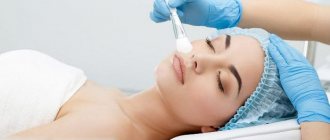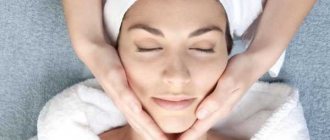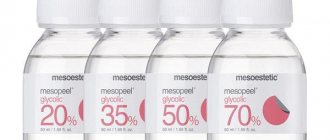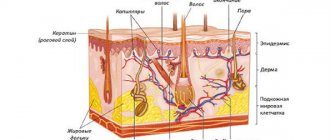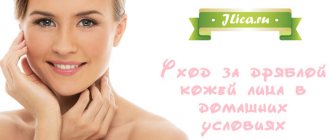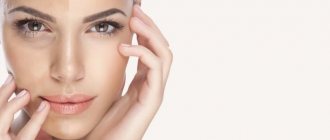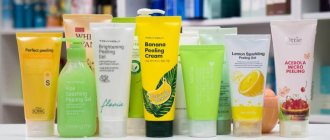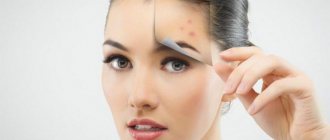Excursion into history
Even in Ancient Egypt, glycolic peeling was used for facial rejuvenation. Historical facts testify to this. The skin was cleansed using sugarcane juice. But not only that - acid was also extracted from the juice of green grapes, pineapples and sugar beets.
Only in the second fifty years of the 20th century did this cosmetic procedure become a special method of rejuvenation. It was at this time that the study of the properties of glycolic acid began, which, as it turned out, can slow down the aging process of the skin and synthesize collagen in it.
Several clinical experiments were conducted that helped spread the method in practice. For example, in 1996, a study was conducted on a group of 41 people. Patients of different ages and different skin conditions were treated with 50% concentration of glycolic acid once a week.
The duration of the experiment is 4 weeks. The results showed that the layer of “dead” cells became noticeably smaller, and the layer of working epidermal cells increased. The skin photosensitivity index has become significantly lower. The face also acquired a more youthful appearance due to the reduction of fine wrinkles.
90% of the experiment participants experienced noticeable changes in the direction of skin rejuvenation. This was documented and the procedure was introduced into the widespread practice of cosmetology.
Stages of a chemical procedure in the salon
Glycolic exfoliation is indicated for patients with any type of skin and for different age categories.
In addition, you need to know that the active substance can act selectively at different depths. It is advisable to undergo peeling in a clinic with professionals in their field.
Therefore, the specialist adjusts the intensity and obtains the desired effect. The process can be safely controlled by adjusting the application layers and correctly selecting the concentration of the main substance. A medical specialist with sufficient experience in this field will clarify all the necessary nuances.
The salon procedure is carried out in three stages:
- Before the procedure, the skin is wiped with a cleansing and degreasing composition.
- The specialist applies glycolic acid with a selected concentration to the surface with a brush. The composition is kept on the skin for some time. At this time, the patient may feel a slight tingling, tingling, itching.
- The third step is the use of a glycolic acid neutralizer.
At the end of the procedure, the skin is moisturized.
On a note! The salon procedure is much more profitable. Here, a specialist will properly prepare the skin, and the procedure will proceed without complications.
Video about this peeling in the salon:
What is a glycolic facial peel?
It is based on the effect of glycolic acid on the skin. This is a chemical reaction. Glycolic acid for the face has a second name - hydroxyacetic acid. It has been used for several decades to heal and rejuvenate the skin.
It is obtained by synthesizing it from sugar cane, beets or green grapes. This fruit acid is used for superficial exfoliation procedures. It is gentle and gentle even on sensitive skin.
How does a chemical glycolic peel work?
The acid penetrates even into the deepest layers of the epidermis. This is achieved by different concentrations of the active substance and leads to:
- Complete dissolution of lifeless cells;
- Destruction of areas containing excess melanin;
- The disappearance of pathogenic microflora;
- Launching cell self-renewal processes due to dermal regeneration or collagen production.
Glycolic peeling for the face is painless if the concentration of acid in the solution is selected correctly and all conditions for its implementation are met.
Preparatory stage
During the consultation, the cosmetologist assesses the condition of the skin and selects the optimal acid concentration. Testing for a possible allergic reaction is required; burning, irritation, and redness are contraindications. The seasonality of cosmetic care is also important; it is not recommended to take the course in the spring-summer period, but in some regions, with reduced solar activity, exfoliation is allowed in March.
Preparation rules:
- You need to stop taking medications a month before, you can’t sunbathe, or carry out procedures that injure the skin;
- During the week you cannot visit the sauna, bathhouse, or gym;
- For patients with dry skin, as well as after 35 years, it is recommended to pre-conduct mesotherapy and biorevitalization;
- to improve the effect, experts recommend using fruit acids in home care with a concentration of no more than 1 percent;
- You may need to take a course of antiviral drugs.
Types of peeling
They differ in the degree of acid concentration and the depth of its penetration into the skin. There are deep, medium and superficial peeling depending on the composition of the solution used, containing 5–10%, 15–30%, 35–50% and 70% acid.
Deeper peeling is carried out with a solution of higher concentration. It is recommended to start with the most gentle doses so that the body can adapt. It is necessary to monitor the skin reaction and stop sessions in time if it is too intense, so as not to harm your health. The procedure may be accompanied by slight tingling.
- If the patient’s problems are related to acne or its prevention, a superficial glycolic cleansing . The impact in this case will be extremely soft and non-traumatic to the skin. But the desired effect will be achieved. The microrelief of the skin will improve, small wrinkles and freckles will disappear, and the patient will be relieved of stagnant acne and acne marks.
- Medium chemical glycolic peeling involves the living layers of the skin. It will penetrate the basement membrane and remove almost completely the epidermis, and along with it, wrinkles and creases will be smoothed out, and the contrast of scars will be neutralized. Peeling has a whitening effect: age spots will gradually disappear. This type of peeling must be carried out in beauty salons. It is also necessary to take into account that it will take 8–15 days for rehabilitation and compliance with all medical recommendations.
- Deep facial peeling is considered the most aggressive, but also the most effective . The acid is able to penetrate the reticular layer of the dermis and lead to complete skin renewal.
The effect of the active substance will completely smooth out wrinkles and folds, completely eliminate hyperpigmentation, scars and get rid of hyperkeratosis.
This method is considered a surgical intervention that requires a serious period of rehabilitation. The procedure is performed only in a hospital, sometimes anesthesia is required.
Where to buy and how much does it cost?
Among ready-made glycolic peels, the product from BELITA-VITEX (50%, pH 2.5), as well as the product from Medical Collagene 3D Easy Peel (10%, pH 2.8), are popular; they can be bought in cosmetic stores, pharmacies, and also order online.
The price for Belarusian-made gel in St. Petersburg is about 1,000 – 1,500 rubles per 250 ml. A Russian product costs on average from 600 to 2,500 rubles, depending on the volume of the bottle.
The minimum price for such a product, for example, in Sevastopol, is approximately 500 rubles.
If, for example, you use belita glycolic peeling (50%, ph 2.5, 250 ml) at home, you need to be careful, as you may encounter a burn.
Glycolic peeling for the face: indications
Exfoliation is used in cases of:
- Expression or age wrinkles;
- Loss of elasticity and firmness of the skin;
- Hyperpigmentation, photoaging or hyperkeratosis;
- Superficial scars or stretch marks;
- Post-acne, tissue compactions accompanying inflammation;
- Uneven skin texture;
- Sebaceous skin and has increased fat content;
- Enlarged pores, seborrhea, peeling;
- Acne, acne, without inflammatory processes.
A cosmetologist can recommend this procedure to those patients who would like to undergo facial plastic surgery, laser resurfacing or deep skin peeling. This requires that the patient be at least 18 years old. But sometimes the procedure is allowed at an earlier age if there are serious skin problems.
Precautionary measures
Chemical exposure has a number of limitations; before carrying out it is important to familiarize yourself with the main contraindications:
- pregnancy, lactation;
- spring-summer period;
- presence of warts, papillomas;
- herpes;
- Fitzpatrick skin types 4 and 5 - dark skin, dark hair and eyes;
- damage to the integrity of the integument;
- inflammatory processes;
- individual sensitivity to the components of the composition;
- rosacea;
- chronic diseases;
- fresh tan;
- carrying out chemotherapy, taking retinoids, hormonal drugs.
Subject to the rules of preparation, recovery and protocol, side effects are minimized. Redness, swelling, and peeling quickly disappear, allowing you to enjoy the result of renewed skin. But in some cases complications may occur:
- 1st and 2nd degree burns are a consequence of violation of the rules for exfoliation, incorrectly selected acid concentration;
- pigmentation is a consequence of violation of the rules of the recovery period or a sign of skin photosensitivity;
- irritation, itching, pimples, red spots appear when the protocol is not followed or contraindications are not identified; in case of swelling and difficulty breathing, you should immediately consult a doctor;
- increased dryness can be caused by the fact that the acid has simply burned the protective barrier; thinning of the skin requires long-term use of moisturizing, regenerating, nourishing cosmetics.
Execution order
The peeling stages must be performed in strict sequence. Only then can you get results. This is also important in order to avoid negative consequences, when facial skin may look worse after the procedure than before it.
Procedure:
- Preparatory stage;
- Direct peeling;
- Acid neutralization procedure;
- Recovery period.
Special attention should be paid to each stage.
Interesting: What is a peeling roller and what effect can you get?
Preparation
Before peeling your face, preparation is important. Before the procedure, you need to add a small amount of hydroxyacetic acid to cosmetics for 7–10 days and use it. It is worth taking 5-10% acid and adding it to your daily skin care products. In this case, you need to ensure that their pH is from 3 to 5.
This helps to normalize the water-alkaline balance in the skin, softens it and adapts it to the possibility of further exposure to the chemical substance on the skin.
There is a scheme specially developed by cosmetologists, according to which acid is used in preparation for the procedure. There is something different for each skin type:
- Owners of oily and combination skin should use cosmetics with acid once a day.
- Those who have dry skin should use cosmetics with acid once a day.
- If you have normal skin, you should use this cosmetics twice a day - morning and evening. As soon as your skin seems dry, reduce application to 1 time.
A trial application of glycolic acid to the elbow should be carried out two days before the facial cleansing procedure. If there is redness in this area. peeling or itching, it is better to refuse the procedure. You can replace cleaning with hydroxyacetic acid with lactic or almond acid. But in any case, it won’t hurt to seek advice from a cosmetologist.
RECOVERY (POST-PEELING CARE)
The rehabilitation period is rightfully considered a full stage of exfoliation, since it largely decides what the final effect will be.
Skin restoration after glycolic peeling lasts 7 days.
At this time it is recommended:
- Stay outside as little as possible
- Use sunscreen with SPF30+,
- Refuse SPA treatments and the gym,
- Refrain from makeup.
It is forbidden to rip off flaky skin: scars may appear in this area. The healing process should be natural: it cannot be forced, for example, with a scrub.
Possible complications
If you ignore the indications and contraindications for glycolic peeling, complications may arise:
- Edema;
- Redness;
- Crusts;
- Tissue burn (incorrect exposure time);
- Exacerbation of pigmentation;
- Dryness;
- Herpes.
If something goes wrong, you need to stop the procedure and wash with a special peeling neutralizer at home (or water with added soda). Then you need to see a doctor.
How to make at home
You can also make a glycolic peeling mask yourself. You just have to stock up on the necessary funds for this. Recipe:
- Degreasing lotion;
- Cream that provides a calming effect;
- Glycolic acid;
- Oily skin moisturizing cream.
Typically, for home use as peeling, buy glycolic acid with a 30% solution. For the first time, it is worth taking a less concentrated acid solution. The concentration percentage is increased gradually so as not to harm the skin.
The first procedure is completed within one minute of exposure. It is not necessary to purchase the finished product in pharmacies; you can prepare it yourself. You will need natural ingredients: lemon juice, cane sugar (1 tablespoon) and 0.5 cups of mineral water.
The products are mixed into a homogeneous mass until the consistency of syrup.
Stages of self-peeling
First, cosmetics and impurities are removed from the face. Then they wash and blot the moisture with a towel.
- Using a fan-shaped cosmetic brush, apply the product in one layer - from the chin to the nose, forehead and cheeks;
- There is no need to apply pressure; do not apply a syrupy mass around the eyes. Keep on your face for 2–15 minutes (depending on the concentration of the solution and the condition of the skin). There should be no burning sensations or redness, otherwise you should immediately wash off the product with a neutralizer. His recipe is simple: dilute a spoonful of regular soda in a glass of water;
- The face is wiped with a cotton swab dipped in the prepared solution. It is necessary to completely remove the active product, and then rinse off the remnants of all solutions with plenty of water and cover the skin with a moisturizer. You can make a mask from wheat germ oil, grape seed oil or jojoba oil.
Types of drugs
Beauty honey - the line is represented by 10% and 30% exfoliants. In addition to glycolic acid, the composition contains lactic, malic, tartaric, and hyaluronic acid. Gentle removal of keratinized cells ensures the launch of rejuvenation processes. As a result, pigmentation lightens, the skin looks well-groomed and refreshed. Hydrobalance is normalized, immune properties are increased. You can buy 50 ml 10% for 1300 rubles, 50 ml 30% - 2142 rubles.
EASY PEEL peeling gel with chizaton based on 10% glycolic acid belongs to the natural series. Prescribed for dry, dehydrated skin with the first signs of aging. Restores firmness and elasticity, promotes skin compaction. Stimulates your own collagen synthesis, provides a slight lifting effect. The composition contains glycolic acid and chitosan and does not require the use of a neutralizer. You can buy 30 ml for 880 rubles.
Premium GLIKOACTIVE - a line of professional cosmetics produces peelings with acid concentrations of 5%, 25%, 50%, 70%. A wide range of products allows us to develop programs individually for each client. As a result, deep renewal occurs, regeneration processes are launched, smooth relief is restored, pigmentation and acne marks are whitened. The cost of premium 200 ml is from 2000 rubles. up to 3500 rub. depending on the acid concentration.
Belita glycolic gel 50% Vitex is suitable for use on all skin types and belongs to the natural line. In addition to glycolic, the formula contains hyaluronic acid, which increases the level of hydration. The procedure is prescribed for acne, hyperpigmentation, signs of chrono and photoaging. Collagen synthesis is activated, the integument becomes denser and more elastic. You can buy 250 ml for 950 rubles.
Compliment glycolic peeling from a domestic brand is intended for the correction of acne marks and rejuvenation. Solves a number of aesthetic problems, launches renewal processes, increases cellular immunity, and blocks the spread of infection. The action of the acid regulates the process of sebum regulation and prevents the formation of sebaceous plugs. You can buy a 7 ml compliment sachet for 30 rubles.
Mary Kay's TimeWise Repair Revealing peeling is designed for aging skin. The formula contains glycolic acid, coconut extract, as well as a complex of antioxidants, vitamins, and minerals. After use, it is possible to reduce the number and depth of wrinkles, refresh color, and strengthen thin capillaries. Witch hazel extract soothes redness and inflammation, tightens enlarged pores. Buy Mary Kay 48 gr. possible for 3500 rubles.
Caudalie Glycolic Peeling Mask is suitable for all skin types. It has no age restrictions and successfully copes with dryness, sagging, and wrinkles. Restores carbohydrate-lipid metabolism, improves the condition of oily dermis. The active components of natural peeling are glycolic acid, viniferine, tannins, papaya enzymes. Suitable for home use, gives the skin a flawless, even tone. You can buy 75 ml for 1890 rubles.
Famous beauty blogger Marina Haifa offers milk-glycol toner in her home facial care program. As a result of application, it is possible to restore texture, even healthy color, and narrow pores. You can buy a cosmetic product by placing an order on the manufacturer’s official website.
Isis pharma peeling cream with 12% glycolic acid is intended for skin care at home. The low concentration of acid helps remove keratinized epithelium without side effects or complications. In addition to glycolic acid, the formula contains plant extracts and minerals. After use, an improvement in color and structure is observed, pores become narrower, and the skin becomes less susceptible to aggressive environmental factors. You can buy Isis Pharma 30 ml for 900 rubles.
Peeling gel Pleyana with glycolic acid 10% is one of the best surface cleansing products. The procedure is indicated for all skin types, to maintain normal condition, as well as solve a whole range of problems. The formula includes glycolic acid, urea, aloe vera, echinacea, calendula, centella, and lemon balm extracts. The product can be used at home or performed in a salon. Used in the treatment program for acne, seborrheic dermatitis, effective for pigmentation, scars, and bumpy relief. You can buy pleyana in the form of a 5 ml sachet for 140 rubles, or the full version 200 ml for 1260 rubles.
Glycolic peeling 70 percent Kosmoteros is used exclusively in a salon setting. It should be used for non-surgical rejuvenation and correction of defects in dermatological diseases. The active ingredient is glycolic acid, which ensures the launch of collagen synthesis. As a result, it is possible to increase the density of the skin, achieve a pronounced lifting effect, and get rid of scars. You can buy 30 ml for 870 rubles.
All inclusive delicate peeling from a domestic brand is suitable for all skin types without age restrictions. It has a powerful rejuvenating and lifting effect, restores skin tone. Suitable for frequent use at home. The composition contains glycolic, citric, malic acid, campfire oil. You can buy 50 ml for 190 rubles.
Glycolic peels on Arcadia Youth skin chitozone are presented in 20%, 40%, 70% concentration. The product line allows you to choose a formula to solve individual aesthetic problems. Peeling gel has an anti-inflammatory and moisturizing effect, restores the protective barrier of the dermis, and blocks melanin synthesis. As a result of application, a structural renewal of the dermis occurs. Suitable for all skin types, cosmetics are used exclusively in salon conditions. The complex contains glycolic, lactic, malic, and tartaric acid. You can buy 50 ml of 20% for 730 rubles, 40% - 900 rubles, 70% - 1160 rubles.
Medical Collagen 3D - peeling gel is intended for professional use. Suitable for sensitive, irritated dermis, has anti-inflammatory, regenerating effects. The formula contains glycolic acid 5% and marine chitosan. Increases firmness, elasticity, tightens pores, removes toxins. Price 30 ml - 785 rub.
Professional glycolic peelings Martinex are available in concentrations of 35%, 50% and 70%. Performed correctly in a salon, the cosmetologist will be able to choose the optimal formula. Prescribed for aging skin, seborrheic dermatitis, acne, hyperpigmentation, as a preparation for other procedures. Only cosmetologists can purchase.
Glycol solution 50% Kenvel is prescribed to moisturize and rejuvenate the skin. Helps cope with the first signs of aging, stretch marks, and acne marks. Activates metabolic processes, restores breathing, improves microcirculation. Suitable for use on all skin types, including oily, inflamed and sensitive. Cost 2600 rub.
Glycoline glyco extreme peel professional product contains 25% AHA acids. Allows you to cope with pigmentation, remove toxins and metabolic products. Restores elasticity, stimulates collagen synthesis. You can buy a package of 24 ampoules of 3 ml for 14,000 rubles.
The Alerana brand specializes in the problem of hair loss. The company's specialists recommend periodically carrying out peeling procedures for the scalp. As a result of deep cleansing, it is possible to get rid of dandruff, seborrhea, and activate the nutrition of the follicles.
How often can you do a glycolic peel?
It is preferable to perform the procedure in autumn or winter, when exposure to sunlight is calmer, which guarantees an unnoticed recovery period. While during the warm period, pigment spots may appear on the face.
If you want to get the most effective result, you should carry out a peeling course from 3 to 10 times, waiting up to two weeks between sessions. But the frequency depends on the condition of the facial skin.
Interesting: Enzyme facial peeling: rejuvenating enzyme therapy.
Advantages and disadvantages
Before you decide to undergo peeling with glycolic acid, it is worth knowing about its features.
Advantages:
- has a soft, gentle effect;
- Suitable for all skin types;
- has no age restrictions;
- harm is minimized due to surface action;
- short recovery period.
Flaws:
- performed according to indications by a cosmetologist;
- requires preparation and allergy testing;
- Cannot be done during periods of solar activity, spring, summer.
Salicylic peeling is prescribed for oily, problematic dermis with frequent rashes and inflammation. Effectively cleans sebaceous plugs and regulates lipid synthesis. Salicylic acid tones and normalizes metabolic processes. It is a superficial type of chemical peeling and has a short recovery period. Combines well with other types of fruit acids.
Peeling with lactic acid is prescribed for stressed, irritated, dehydrated skin for the purpose of moisturizing and rejuvenating. Superficial exfoliation has a gentle effect on the skin, removes toxins and oxidants. The composition can be used for the neck, décolleté, and arms.
Side effects for the face
If a low-quality product is used or the exposure time is incorrectly selected, complications may arise in the form of peeling side effects.
The most noticeable problems:
- Swelling. A few hours after the procedure, swelling may occur, which usually disappears without a trace. But with the new procedure you need to be more careful.
- Burns. Redness or burning sensations that occur after the procedure are eliminated by rinsing the face with cold water and applying a soothing cream.
- Allergy. This type of reaction can be avoided by first performing a test by applying a small amount of acid to the crook of your elbow or wrist. To determine how the drug is tolerated, wait for 7 to 10 minutes. And, if itching, burning, swelling or redness appears on the skin, then you should not use glycolic peeling for the face.
- Dark spots. In those prone to pigmentation, it may intensify.
- Dryness. Reducing the concentration of the solution will help avoid dryness or flaking of the skin, which is susceptible to such changes. At the end of the procedure, you should lubricate your face with moisturizer.
Healing period
During the first hours, redness, swelling, and puffiness may be observed, which disappear on their own after a few days. On the third day, it is possible to separate the epithelial plates; to speed up the renewal, you can use medicinal ointments or moisturizing creams.
Attention! The entire recovery period lasts no more than a week. It is important to follow the cosmetologist’s recommendations to prevent complications and achieve a lasting aesthetic effect.
Recovery period rules:
- Limit touching your face for the first 24 hours;
- for cleansing, use gentle foams with a neutral pH;
- do not use new cosmetic products to avoid an allergic reaction;
- Bepanten, Panthenol or creams based on aloe vera and hyaluron will help speed up healing;
- makeup can be used after complete recovery, carefully select powder and foundation with an anti-comedogenic effect;
- It is recommended to give up alcohol, spicy and salty foods for a week;
- you cannot sunbathe, visit the sauna, swimming pool, solarium, or gym for a month;
- Be sure to use sunscreen with the maximum SPF factor.
Contraindications to glycolic peeling
Peeling with glycolic acid should not be used in cases where:
- There are abrasions, scratches, wounds or inflammation on the face;
- Skin intolerance to the drug and its constituent substances was discovered;
- If acute herpes is observed in the treated areas;
- When there are chronic diseases;
- Photosensitivity of the skin is observed;
- There are warts or other growths on the skin;
- Recently tanned;
- Dark skin color can cause hyperpigmentation - the difference between treated and untouched areas of the skin;
- When a patient takes retinoids (vitamin A), the chemical effect increases, which has a negative effect on the skin.
- Recently completed eyebrow correction and hair removal.
Peeling during pregnancy
In this case, glycolic peeling of 10% concentration is allowed. This solution is not able to penetrate either the fetus or the milk; only the result of exfoliation will be difficult to predict, since the hormonal levels of pregnant and nursing mothers are not stable. A gynecologist and cosmetologist can help in this matter.
Reviews
OKSANA:
“I had a glycolic peel done in the salon with a solution of 70% concentration. So I hoped to get rid of age spots, acne marks and shallow wrinkles.
The result pleasantly surprised me, especially the almost complete smoothing of the scars. The course consisted of 10 procedures"
KARINA:
“Undoubtedly, hydroxyacetic acid helps renew the skin very well, but after a salon procedure performed by a specialist, I returned home with a red face and then sat at home for several days and was saved by Panthenol.
Apparently, my skin didn’t like this treatment, although later it began to look much better than before.”
ALINA, 47 YEARS OLD:
“If you decide to test a product with glycolic acid on yourself at home, then my advice to you is: under no circumstances increase its concentration, because in this way I got a burn all over my face with all the ensuing consequences.
I live in St. Petersburg, it’s easy to buy peeling here for home use, it is sold in many stores. I used Belita glycolic peeling (50 ph 2.5) because I read positive reviews about it. I had to recover for a long time after using it.”
Properties of glycolic acid and benefits for the skin
For glycolic peeling, glycolic (hydroxyacetic) acid is used. You can get it without any problems from natural products (sugar cane, grapes and beets).
Hydroxyacetic acid is involved in rejuvenating and cleansing the skin, treating and improving it, thanks to the following properties:
- rejuvenating effect - the acid penetrates into the skin and stimulates the active synthesis of collagen and fibroblasts. As a result of this activity, the turgor of the epidermis increases, the relief of the skin is smoothed, deep and medium wrinkles are less noticeable, and small ones disappear altogether;
- deep penetration and cleansing - the hydroxyacetic acid molecule has a very small molecular weight compared to other fruit acids, so it penetrates deeper. The exfoliant reaches deep layers, where it actively acts, destroys connections between dead cells, and fights keratinization;
- provides a lifting effect - after exposure to hydroxyacetic acid on cells and intercellular space, they swell. Thus, the elasticity of soft tissues increases, the relief is smoothed and the depth of wrinkles is reduced;
- anti-inflammatory – glycolic peeling is used for medicinal purposes against acne and acne. The exfoliant prevents the development of the disease, reduces inflammatory processes, which leads to the extinction of infected lesions on the face;
- moisturizing – after exfoliation with glycolic acid, the skin becomes soft and moisturized. The acidic ingredient normalizes the pH balance of the epidermis, enhances metabolic processes and the functioning of the sebaceous glands, which has a positive effect on the general condition of the skin.
Ease of penetration and effectiveness are the main features of glycolic acid. In a short time you can brighten your skin, cure problematic acne, refresh your face and whiten age spots and freckles.
Chemical peeling with glycolic acid very rarely causes an allergic reaction in the patient. The main component of the product is easily perceived by epidermal cells and corrects their work without complications or unpleasant consequences.
Result and before and after photos
The results of this soft cleaning in photographs
- The presence of wrinkles on the face;
- Acne marks, scars, post-acne spots;
- Flabby skin in need of increased vitality;
- Excessively oily skin due to increased activity of the sebaceous glands;
- Skin that has an earthy tone;
- Enlarged pores;
- Excessive pigmentation;
- Aging of integuments due to solar activity;
- Preparation for facial surgery or the period after surgery, but only as directed by a doctor.
